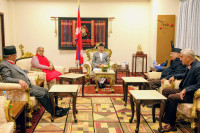Fri, Dec 26, 2025
Opinion
Unsung creators
Intellectual property has been given little attention as it is seen as a Western concept
bookmark
Nischal Dhungel
Published at : March 29, 2018
Updated at : March 29, 2018 08:04
The Paris Convention for the Protection of Industrial Property, adopted in 1883, recognised the importance of intellectual property rights (IPRs) which give creators the exclusive right to exploit and benefit from their creations. In Nepal, IPRs seem to have been completely neglected. And with the government working to upgrade Nepal’s status from least developed country to developing country, this is the right time to plan, execute and implement policies related to IPRs. The World Intellectual Property Organisation (WIPO) has divided intellectual property into two categories: Industrial property consists of inventions, trademarks, industrial designs and geographical indications. Likewise, copyright refers to writings, films, music, artistic works and architectural designs.
The history of IPRs in Nepal dates from the Rana regime when prime minister Juddha Shumsher enacted the Nepal Patent, Design and Trade Mark Act in 1936. The new constitution recognises IPRs which are defined in Article 25. Nepal joined WIPO in 1997 and became a signatory to the Paris Convention for the Protection of Industrial Property in 2001. Nepal became a member of the World Trade Organization (WTO) in 2004, and subsequently signed the Trade-related Aspects of Intellectual Property Rights (TRIPS) agreement. Similarly, Nepal joined the Berne Convention for the Protection of Literary and Artistic Works in 2006.
Lack of frameworks
The existing laws and policies governing IPRs are the National Intellectual Property Policy 2017, Patent, Design and Trademark Act 1965 and Copyright Act 1965. The essence of industry related IPRs has been highlighted in Nepal’s Trade Policy 2015. According to Industrial Statistics 2015-16 published by the Department of Industry, the trend of trademark and design registration looks quite promising, but the trend of patent registration is very depressing. In fiscal year 2015-16, a total of 2,398 trademarks and 11 designs, both national and foreign, were registered. No patents were registered. In the global context, Nepal’s Intellectual Property Rights Index score increased by 0.48 to 4.94, placing it in the 15th position in Asia and Oceania and in the 76th position in the world in the list published by the Property Rights Alliance.
In the present context, IPR activities in Nepal are confined to the areas of patent, copyright, trademark and design. There are other forms of intellectual property such as geographical indications, trade secrets, integrated circuit designs and new plant varieties recognised by TRIPS. There are no legal frameworks to govern such intellectual property in Nepal. Despite being a member of WIPO, it hasn’t signed WIPO’s Copyright Treaty and Performances and Phonograms Treaty. Infringement and ambiguity in terms of registration and ownership of trademarks are rampant in Nepal. Recently, Magic Footwear published notices in the newspapers warning manufacturers that they face legal action if they copy its trademark.
The inflow of foreign direct investment into Nepal has been rising, so it should create an enabling environment for foreign investors to invest by providing IPRs. Foreign companies have modern patented technology and they can produce goods of a better quality than domestic firms. Once the country’s technological ability crosses a certain threshold, the imitation effect will be gradually reduced, and the innovation effect will prevail in the economy. The adoption of a legalised regime of IPRs led to the growth of India and China in the field of agriculture, industry and services. They have leapfrogged exponentially which has alarmed Western businesses.
Necessity of intellectual property
Currently, there are separate laws for the protection of industrial IPRs and copyrights. Therefore, the government should set up a single regulatory body for IPRs. Once the patent is registered, it should be properly regulated in the economy. Nepal must collaborate with international institutions to support the establishment of intellectual property in the country. Nepal faces a huge challenge preventing the sale of counterfeit goods. Intellectual property related matters must be included in the curriculum in order to make them relevant to the needs of stakeholders, that is businesses and the community at large. Nepal should update and reform its existing IPR laws and policies to meet international agreement commitments.
Many countries are delving into the burgeoning growth of crypto currency. New questions have been raised about ownership, legal protection and intellectual property laws. Modern intellectual property laws have yet to be applied to the block chain technology field. Nepal is still working to establish an electronic filing system related to IPR. Nepal also struggled to secure unique orthodox tea that is famous for its quality, aroma and aftertaste. On a positive note, the Nepali tea industry has a brand new logo. Nepal needs to utilise this opportunity to boost exports of orthodox tea. Goldstar is a good example of a company that has redefined and rebranded itself to become a leader in the country’s shoe industry.
The conventional wisdom about IPRs has it that Western-style intellectual property protection brings many costs and few benefits to developing countries. Actually, a country can prevail over the negative aspects if it uses intellectual property technology to stimulate domestic innovation and boost foreign investment. The promotion and protection of intellectual property creates new jobs and industries, and spurs economic growth leading to technological advancement and economic development of the country.
Dhungel is a fellow of the Nepal Economic Forum
Most Read from Opinion
Editor's Picks
Pradeep Adhikari’s flight to power—and the turbulent fall
Ride-hailing no easy option for students struggling to commute in Kathmandu
Is Oli’s victory over Ishwar Pokhrel also a final defeat for Bidya Bhandari?
Nepal scales back key SDG health targets
Nepal’s ban fails to stop Nepalis from working in Iraq
E-PAPER | December 26, 2025
×




 13.12°C Kathmandu
13.12°C Kathmandu











